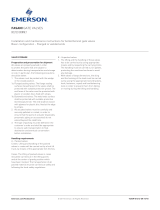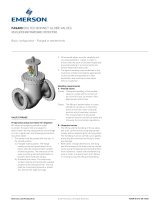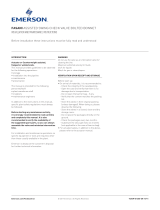Page is loading ...

FASLT-0012-EN 16/09
FASANI THROUGH CONDUIT SLAB TYPE BOLTED BONNET VALVES
InstallatIon and MaIntenance InstructIons
SECTION 1 - VALVE STORAGE
1.1 Preparation and preservation for
shipment
All valves are properly packed in order
to protect the parts that are subject to
deterioration during transportation and storage
on site. In particular, the following precautions
should be taken:
1. The valves must be packed with the slab in
the closed position.
1a. Flanged sealing valves: The flange
sealing surfaces (raised faces) of the
valves shall be protected with suitable
protective grease. The end faces of the
valve must be protected with plastic or
wooden discs fixed with straps.
1b. Buttweld end valves: The weld ends
surface shall be protected with suitable
protective like Deoxaluminite. The end
shall be closed with plywood or plastic
disc fixed at the edge by straps.
2. All actuated valves must be carefully and
securely palleted or crated, in order to
ensure that the parts of actuator (especially
pneumatic piping or accessories) do not
extend beyond the skid/crate.
3. The type of packing must be defined in the
customer’s order and shall be appropriate
to ensure safe transportation to final
destination and eventual conservation
before installation.
Through conduit slab type bolted bonnet valves
Basic configuration - Flanged or welded ends
1.2 Handling requirements
A - Packed valves
Crates: Lifting and handling of the packed
valves in crates will be carried out by a fork lift
truck, by means of the appropriate fork hitches.
Cases: The lifting of packed valves in cases
should be carried out in the lifting points
and at the center of gravity position which
have been marked. The transportation of all
packed material must be carried out safely and
following the local safety regulations.
B - Unpacked valves
1. The lifting and the handling of these valves
has to be carried out by using appropriate
means and by respecting the carrying limits.
The handling must be carried out on pallets,
protecting the machined surfaces to avoid
any damage.
2. With valves of large dimensions, the sling
and the hooking of the load must be carried
out by using the appropriate tools (brackets,
hook, fasteners, ropes) and load balancing
tools in order to prevent them from falling
or moving during the lifting and handling.
CONTENTS
1 Valve storage 1
1.1 Preparation and preservation for shipment 1
1.2 Handling requirements 1
1.3 Storage and preservation before
Installation 2
2 Installation 2
2.1 Preparation before installation 2
2.2 Installation instructions 3
2.3 Periodic valve verification during service 3
Table I: Bolt torque for bonnet bolts 4
Troubleshooting guide 4
3 Operation and maintenance instructions 5
3.1 Packing maintenance 5
3.2 Flange gasket replacement 5
4 Valve removal 5
5 Lubricants and special tools 5
5.1 Lubricants 5
5.2 Special tools 5
Table II: Grease and lubricant list 5
www.valves.emerson.com © 2017 Emerson. All rights reserved.

2
FASANI THROUGH CONDUIT SLAB TYPE BOLTED BONNET VALVES
InstallatIon and MaIntenance InstructIons
1.3 Storage and preservation before
installation
In case the valves have to be stored before
installation, the storage has to be carried out
in a controlled way, and has to be performed in
accordance with the following criteria:
1. The valves have to be stocked in a closed,
clean and dry storage room.
2. The slab must be in the closed position,
and the end faces must be protected with
plastic or wooden discs fixed with straps. If
possible, keep the original protection.
3. Periodical checks have to be carried out
in the storage area to verify that the above
mentioned conditions are maintained.
For actuated valves, in addition to the above,
please refer to the warnings in the manual of
the actuator.
Caution
For valve handling and/or lifting, the lifting
equipment (fasteners, hooks, etc.) must be sized
and selected while taking into account the valve
weight indicated in the packing list and/or delivery
note. Lifting and handling must be made only by
qualified personnel.
Do not use the lifting points located on the
actuator, if any, to lift the valve. These lifting
points are for the actuator only.
Caution must be taken during the handling to
avoid that this equipment passes over the workers
or over any other place where a possible fall
could cause damage. In any case, the local safety
regulations must be respected.
SECTION 2 - INSTALLATION
2.1 Preparation before installation
1. Carefully remove the valve from the
shipping package (box or pallet) avoiding any
damage to the valve or, in case of automated
valves, to the electric or pneumatic/
hydraulic actuator or instrumentation.
2. The valves are shipped with the ends
protected with caps and a thin layer of
protective grease. Before installing the
valve, remove the caps and clean carefully,
then degrease both surfaces with a solvent.
Clean the inside of the valve by using an air
line. Ensure that there are no solid objects
such as pieces of wood, plastic or packing
materials within the valve or on the valve
seat.
3. Confirm that the materials of construction
listed on the valve nameplates (service and
temperature) are appropriate for the service
intended and are as specified.
4. Define the preferred mounting orientation
with respect to the system pressure.
If any (see arrow on the body), identify
the upstream side (high pressure) and
downstream side (low pressure).
NOTE:
1. Storage in an open area for a limited period can
be considered only in case the valves have
appropriate packing (packed in cases lined with
tarred paper, and contents well protected with
barrier sacks).
2. Do not place consignment packages directly on
the ground.
3. Do not expose consignment packages to the
weather or directly to the sun.
4. Check the packaging every two months.
Warning
Verify that the direction of the flow in the line
corresponds to the arrow indicated on the valve
body. Valves without the arrow are bi-directional.
See the actuator user manual for the actuator
preparation.
FIGURE NO. 1
VALVE SLINGING

3
Important
If piping system is pressurized with water for
testing, and in case the piping system has been
shut down after testing for a long time, the
following recommendations should be adopted.
a. Use corrosion inhibitor with water to
pressurize the piping system
b. After testing, the piping system should be
depressurized and the test water completely
drained.
FASANI THROUGH CONDUIT SLAB TYPE BOLTED BONNET VALVES
InstallatIon and MaIntenance InstructIons
2.2 Installation Instructions
Through conduit valves are normally installed
in horizontal pipe with vertical stem.
For a correct operation, Fasani recommends
that the valve shall be installed and oriented
following the indications of fig. 2. Different
positions from those indicated may cause a
non-correct valve operation, and/or a quick
deterioration of the valve.
Unless otherwise recommended by Fasani, the
valve should be installed with the slab in the
closed position, to ensure that the seat ring
in the slab is not damaged during installation.
Particular care should be taken with those
valves equipped with ‘fail-open’ actuators.
Handling and lifting of the valves during
installation MUST be performed following the
same criteria and instructions described in
previous points “1.2 Handling requirements”
and “1.3 Storage and preservation before
Installation”.
Important
After the valves installation and before the line
testing, it is recommended to perform an accurate
cleaning of the lines to eliminate dirt and any
foreign objects that could seriously jeopardize
the tightness between seat/disc and the correct
operation of the valve.
Buttweld valves
Position the valve and check the alignment
with the pipe, then proceed with welding,
in accordance with the applicable welding
procedure.
Flanged valves
Place the valve between the two flanges of the
pipe and put the seal gasket between the valve
flange and the pipe flange; make sure that it is
correctly positioned. Then assemble the valve
to the pipe by the bolts which will be tightened
crossing. Progressively reach the requested
torque value indicated by the Engineering
Company that designed the plant.
2.3 Valve verification before start up
1. Check the operation of the valve by stroking
it to “full open” and “full close”.
2.4 Operations instructions
The following instructions will help provide a
satisfactory and long life service of the through
conduit bolted bonnet valves:
1. Make sure to perform periodic valve
verification as described in paragraph 2.5.
2. In case of actuated valves always follow the
specific instructions given by the actuator’s
manufacturer.
3. Never change the setting of torque and/or
limit switches which have been carefully set
during the final test at Emerson workshop.
FIGURE NO. 2
INSTALLATION POSITIONS RECOMMENDED
After the valve installation on the line and
before the line pressurization, the following
activities must be performed:
- all the threads plugs tightening shall be verified
- torque of the body-bonnet bolts shall be verified
- the valve has to be fully stroke operated
See table I (Bolt torque figures for body-
bonnet flanged connections). If any, see the
actuator instruction manual for the related
commissioning start-up procedure.

4
½ 9 66 90 3 19 26
⅝ 18 129 175 5 37 50
¾ 31 224 305 9 64 87
⅞ 50 358 487 14 102 139
1 74 533 725 21 152 207
1 - ⅛ 107 772 1050 31 221 300
1 - ¼ 149 1075 1462 43 307 418
1 - ⅜ 201 1447 1968 57 413 562
1 - ½ 263 1896 2579 75 542 737
1 - ⅝ 339 2445 3325 97 699 950
1 - ¾ 426 3072 4178 122 878 1194
1 - ⅞ 527 3798 5165 150 1085 1476
2 642 4630 6297 183 1323 1799
2 - ¼ 921 6640 9030 263 1897 2580
2 - ½ 1271 9162 12460 363 2618 3560
2 - ¾ 1537 11085 15076 439 3167 4307
3 2003 14447 19648 572 4128 5614
3 - ¼ 2556 18428 25062 730 5265 7161
3 - ½ 3201 23079 31387 914 6594 8968
FASANI THROUGH CONDUIT SLAB TYPE BOLTED BONNET VALVES
InstallatIon and MaIntenance InstructIons
2.5 Periodic valve verification during service
A - Normal check
1. Verify monthly that there is no leakage from
the body/bonnet area.
If the leakage has been detected from the
body/bonnet area, tighten the nuts (pos. 31)
as indicated in Table I.
If the leakage does not stop, follow the
maintenance procedure for the replacement
of the body/bonnet flange gasket (3.2).
2. Every 2 / 3 months, depending on operating
frequency, verify the greasing of bearings
and stem thread.
3. For actuated valves, in addition to the above,
please refer also to the warnings in the
actuator manual.
TROUBLESHOOTING GUIDE
Symptom Possible cause Solution
Stem packing leaking Packing damaged. Replace packing (See paragraph 3.1)
Body-Bonnet leaking Body-bonnet flange bolting loose. Tighten bottom flange bolting.
Gasket damage. Replace the gasket.
Valve leaking Valve not fully closed. Close valve.
Debris trapped in valve. Cycle and flush (with valve open) to
remove debris.
Sealing surface damaged. Recondition the seat surface.
Jerky operation Air supply inadequate (for pneumatic act.) Increase air supply pressure.
TABLE I: BOLT TORQUE FIGURES FOR BODY-BONNET FLANGED CONNECTIONS
Nominal bolt Materials: A193 B7 / A193 B16 / A320 L7 Material: A193 B8
diameter Torque Torque Torque Torque Torque Torque
(In.) Kgm Ftlb Nm Kgm Ftlb Nm
B - Preventive actions
1. Every 6 months on motorized valves and
every 8 months on hand operated valves,
grease stem and bearings.
2. Every 4 years disassemble the critical
service valves and/or actuated valves,
verifying the sealing surfaces and lap them
again when necessary. Substitute the
bonnet gasket and the packing, grease the
stem.
3. For the actuator, proceed as indicated in its
maintenance manual.
(Corresponding to approx. 40% of yield strength on dry steel surfaces)

5
Warning
Before starting any maintenance, depressurize,
drain and vent the line; check that the valves are
not in temperature; disconnect any electrical
power supply.
Failure to do so may cause serious personal injury
and/or equipment damage.
Warning
Before starting any maintenance, depressurize,
drain and vent the line; check that the valves are
not in temperature; disconnect any electrical
power supply.
Failure to do so may cause serious personal injury
and/or equipment damage.
FASANI THROUGH CONDUIT SLAB TYPE BOLTED BONNET VALVES
InstallatIon and MaIntenance InstructIons
SECTION 3 - MAINTENANCE
The Through Conduit valves have been
designed to require minimum maintenance.
This manual describes on site repairs as:
- Packing maintenance
- Body/Bonnet flange gasket maintenance
All the other repairs should be performed by
Emerson or nominated service company.
3.1 Packing maintenance
If leakage is observed through the packing,
replace the packing as follows:
1. Remove the yoke
2. Remove the worm-out packing using a
hooking wire
3. For a better tightness, proceed to an
accurate cleaning of the stem and stuffing
box and make sure there are no scratches
or signs of seizing
4. The repacking shall be carried out by
placing one ring at a time around the stem,
inside the stuffing box
5. Cycle the valve.
6. Pressurize the line.
3.2 Body-bonnet flange gasket replacement
1. Before replacing the gasket, carefully clean
the flange surfaces.
2. Place the gasket in its seat and begin
to carefully position the bonnet flange.
Position it perfectly parallel to the gasket
face; do not use the bolts to obtain this
alignment.
3. In case the coupling is vertical (valve with
horizontal stem), position the bonnet flange
by means of a hoist; lock it with four bolts
placed at 90° on from the other and tighten
them until the flanges are perfectly coupled
in their seat. Insert all the other bolts.
4. During tightening, make sure that the faces
of the flanges remain perfectly parallel.
5. Tighten the bolts in the sequence indicated
in fig. 3, using for the first turn a torque of
approx. ¼ of the maximum torque listed
on table I. For a better performance of the
joint, tighten again all the bolts after the
equipment has been pressurized.
FIG. NO. 3
SECTION 4 - VALVE REMOVAL
If the valve needs to be removed from the line
for some extraordinary reason, the user should
ensure the following:
1. The valve is depressurized, drained and
vent.
2. The pipe shall be cut as far away from the
valve as possible (only for welded valves).
SECTION 5 - GREASES AND SPECIAL TOOLS
5.1 Greases
To lubricate the bearings on manual and
gearbox operated valves, we suggest to use
the grease AGIP GRMUEP2 or an equivalent
product, as showed in the following table:
TABLE II: GREASE AND LUBRICANT LIST
Manufacturer Grease
AGIP GRMUEP2
API PGX2
BP GREASE LTX2
ESSO BEACON 2
FINA FINAGREASE HP FINAGREASE EPL2
MOBIL MOBILUX EP2
Q8 REMBRANDT EP2
SHELL ALVANIA R2 SUPERGREASE A
TEXACO MULTIFAK EP2 GREASE L2
TOTAL MULTIS EP2 MULTIS 2
VISCOL SIGNAL ROLSFER 2
STATOIL UHIWAYLI LI G2
5.2 Special tools
No special tool required for the maintenance
operation described in this manual.
For the lubrication of the stem thread, use the
grease SIGNAL CEP 30 produced by Viscol. As
an alternative you can utilize:
- CEPLATTYN 300 produced by REINER-FUCHS
- GRAFLOSCON produced by KLUBER
You can also use a grease having more than
25% pure graphite content (carbon 98%)
granulometry 5m, without any abrasive agent.
For the lubrication of the actuator, refer to the
relevant manual.

© 2017 Emerson. All rights reserved.
/









